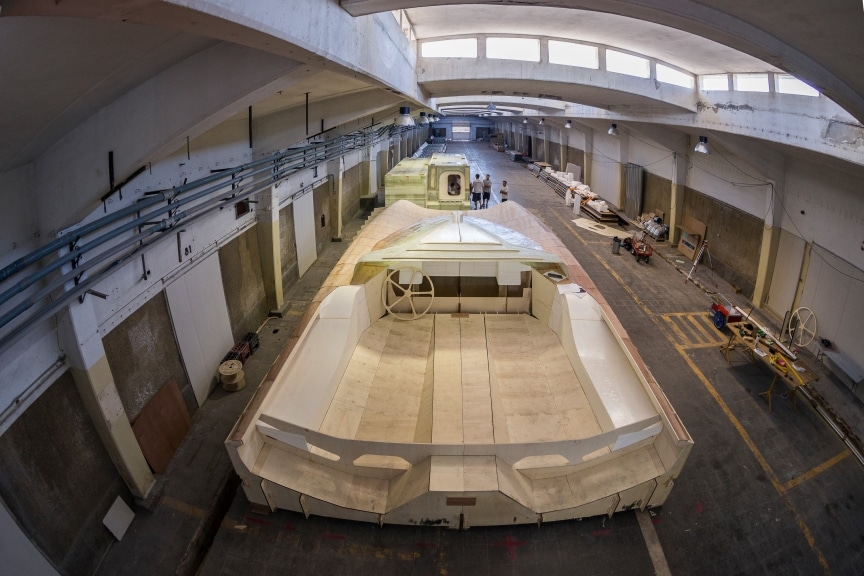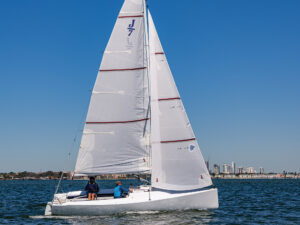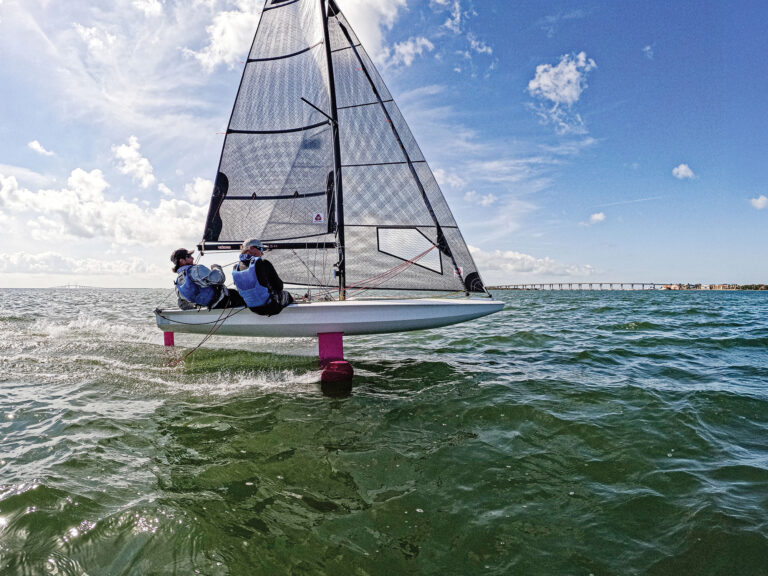
Super 60 Mock-up in the Boatyard, Lisbon, Portugal. Volvo Ocean Race 2017.
Just over three months ago, on 18 May 2017, Volvo Ocean Race CEO Mark Turner stood on a stage in the Volvo Museum in Gothenburg and announced that the question of whether the future of the race was monohull or multihull had been solved.
In fact, the Volvo Ocean Race had opted for both – and would design and build a one-design foil-assisted 60-foot (18.29 metre) monohull for the ocean legs, and a one-design 32-50 foot foiling catamaran (10-15 metre) for use inshore at the stopovers.
Now, with the 2017-18 edition already apace following a thrilling Leg Zero, work on the two new boats has been moving very fast in the background.
This week, the first mock up of the Guillaume Verdier-designed offshore monohull was revealed at the Boatyard in Lisbon – and it looks incredible.
“We contacted several designers and asked them to submit their ideas for both a complete stand-alone Volvo Ocean Race boat, or with the potential to convert to an IMOCA boat,” said Bice.
“All the designers that we invited to present were very strong, it wasn’t clear cut – we had some pretty serious soul-searching to decide what we wanted to do. I went to New Zealand and spent a day with Guillaume to get to know him, and we decided he was our man.”
Verdier recently came to prominence as a designer for the foiling 2016 Vendée Globe boats, and for the 36th America’s Cup winners, Emirates Team New Zealand.
“We’ve created the Volvo Ocean Race Design Team as a collaboration, getting the best input from everywhere,” said Bice. “It’s going to be a very cool boat; imagine coming into the finish, in a harbour in 20 knots of breeze and you are going to see this thing fully airborne, foiling, at 35 to 40 knots.”
Verdier has now gathered his team around him, and they have been working hard on the hull lines. The design has developed in a way that will enable IMOCA 60 compatibility, making it convertible, relatively quickly and inexpensively, to a short-handed rules-compliant IMOCA boat for events like the solo Vendée Globe and two-up Barcelona World Race.
“We don’t think there is any compromise to making a stand-alone Volvo Ocean Race boat comply with the IMOCA 60 rules. Although in Volvo mode, we will have another keel, we will have different rudders, foils, we will have a different rig on it,” said Bice.

Super 60 Mock-up in the Boatyard, Lisbon, Portugal. Volvo Ocean Race 2017.
“So now, with the new two-year race cycle, a team can compete in an IMOCA event in between, maintaining profile for a sponsor and making it much easier for them to commit to two cycles of the Volvo Ocean Race. That’s what we want to try and achieve.
“We are on a critical path with the plan that the eighth boat has to be launched by June 2019, that’s the bookend of the whole project. Working all the way back from that, we need to start machining the moulds in September. Then we need to start laminating the first boat at the end of February, early March next year.
“Persico will be the lead contractor, it’s about 40,000 hours per boat but we want to try and eliminate the need for transportation, so they will definitely do the hull and deck, put the composite shell together. Then it gets delivered to The Boatyard in Lisbon, and we will do the painting and the fit out. It’s very similar to what we did with AkzoNobel, the latest Volvo Ocean 65 built for this race.”
This is where Neil Cox and his Boatyard team will come in. “Roughly, it will take six months at Persico so the first boat will arrive at The Boatyard facility in September 2018, two months after the next race ends. It needs to be finished by the end of November 2018, with the whole fleet ready by the middle of 2019. So we get a new boat every four weeks. It will go into our process for roughly three months, painting, fit-out and then branding of the boat,” said Cox.
The tender period closed for the inshore foiling multihull at 1200 CEST on the 31 July and 16 proposals were received – a remarkable response from the marine industry.
Nick Bice – Chief Technical Development Officer – and his team must sift through them and make a decision on which proposal to take forward. “We want to announce the result during the prerace festivities, in Alicante in mid-October,” Bice explained, taking a short break from Leg Zero debriefing with Cox.
And all this with a race going on at the same time. “It’s a demanding time,” added Cox. “In the last three weeks emails have started coming in quicker than you can fire them back out. Normally you can manage your email, but now the computer updates itself, and you are like, ‘How did 30 emails just come in, in 10 minutes?’ You can feel the momentum building from every angle.”
And with that, it’s time for the guys to get back to it.









